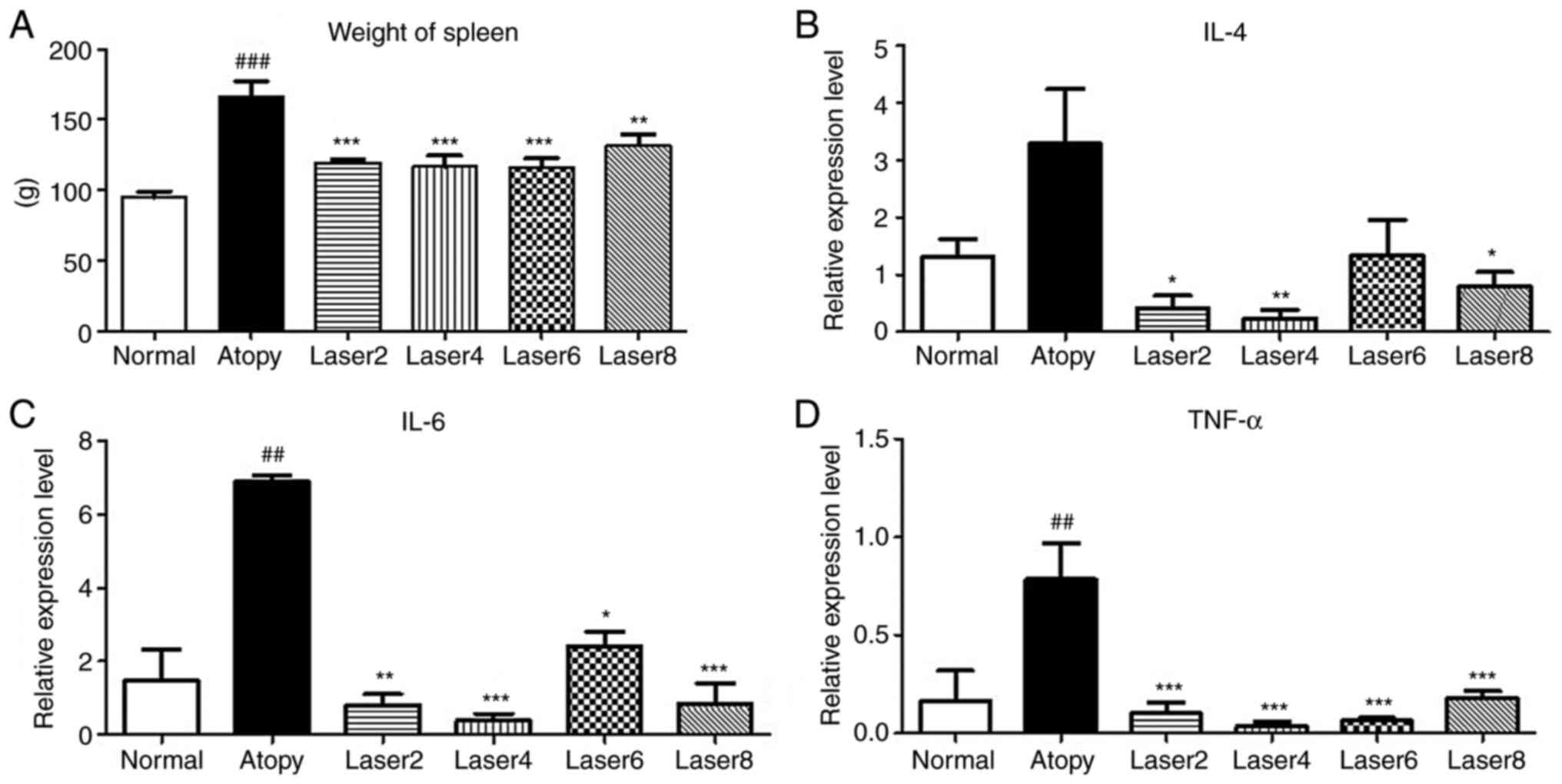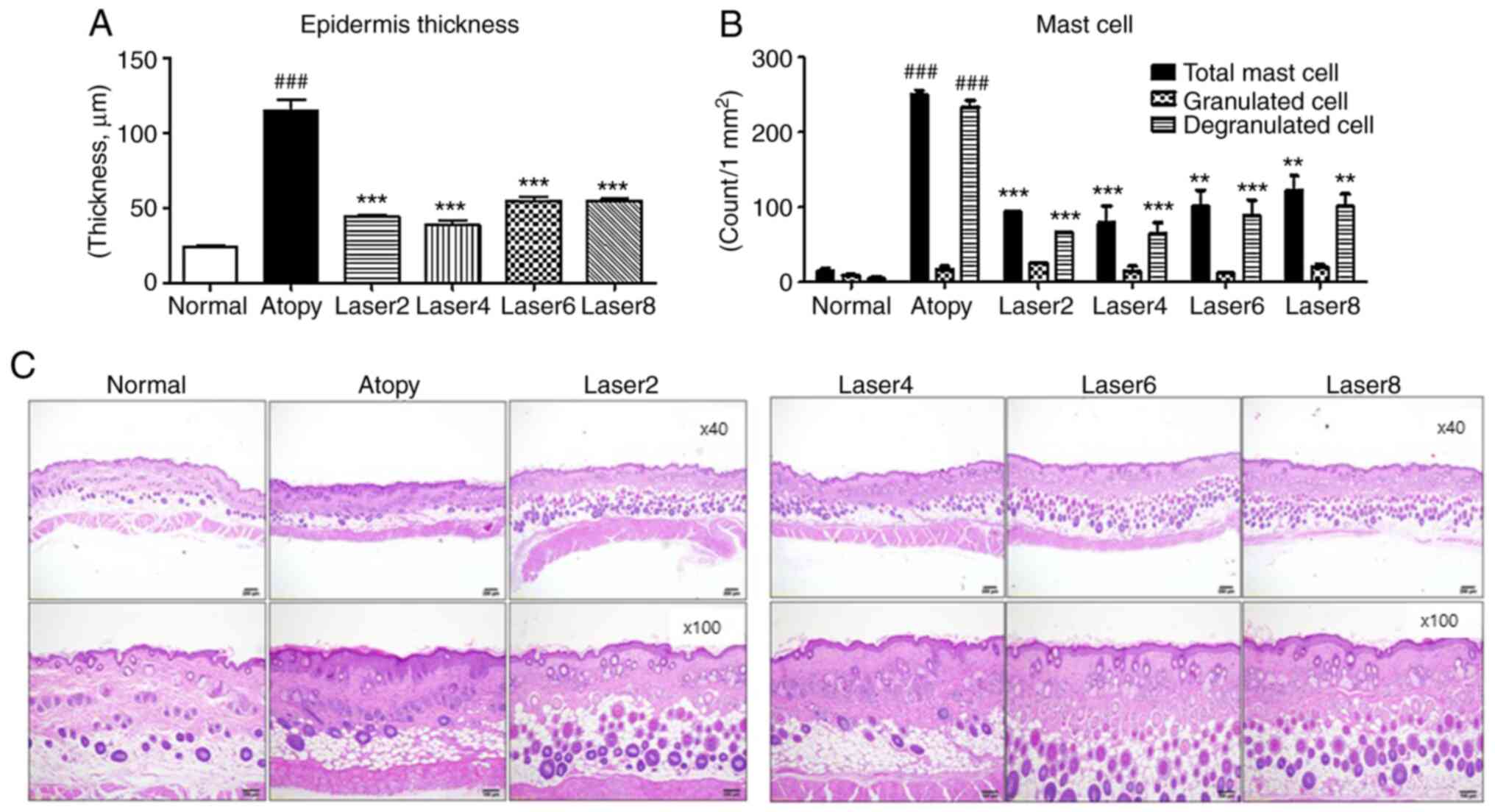|
1
|
Bieber T: Atopic dermatitis. Ann Dermatol.
22:125–137. 2010.PubMed/NCBI View Article : Google Scholar
|
|
2
|
Sandstrom MH and Faergemann J: Prognosis
and prognostic factors in adult patients with atopic dermatitis: A
long-term follow-up questionnaire study. Br J Dermatol.
150:103–110. 2004.PubMed/NCBI View Article : Google Scholar
|
|
3
|
Youssef DM, Elbehidy RM, El-Shal AS and
Sherief LM: T helper 1 and T helper 2 cytokines in atopic children
with steroid-sensitive nephrotic syndrome. Iran J Kidney Dis.
9:298–305. 2015.PubMed/NCBI
|
|
4
|
Hanzlikova J, Ulcova-Gallova Z, Malkusova
I, Sefrna F and Panzner P: TH1-TH2 response and the atopy risk in
patients with reproduction failure. Am J Reprod Immunol.
61:213–220. 2009.PubMed/NCBI View Article : Google Scholar
|
|
5
|
Horsmanheimo L, Harvima IT, Jarvikallio A,
Harvima RJ, Naukkarinen A and Horsmanheimo M: Mast cells are one
major source of interleukin-4 in atopic dermatitis. Br J Dermatol.
131:348–353. 1994.PubMed/NCBI View Article : Google Scholar
|
|
6
|
Jung JH and Kim GJ: Anti-inflammatory
effects of herbal medicines (Rubus coreanus, Rehmanniae Radix,
Houttuynia cordata, Betulae cortex) EtOH extract on acute atopic
dermatitis mice. J Korean Med Ophthalmol Otolaryngol Dermatol.
28:68–84. 2015.
|
|
7
|
Lim YY, Kim HM, Jang WS, Seo SH, Ahn HH,
Kim Mn and Kim BJ: Study on tests of skin safety and inhibition of
atopic dermatitis using a StoneTouch® infrared scanner
in a mouse model. Korean J Dermatol. 49:217–226. 2011.
|
|
8
|
Lim YY, Jang WS, Kim HM, Kim IS, Lee JW,
Kim MN and Kim BJ: Therapeutic effects of light emitting diode on
atopic dermatitis-like lesions in NC/Nga mice. Korean J Asthma
Allergy Clin Immunol. 31:207–214. 2011.
|
|
9
|
Kwon TR: UV-LED 310-nm and 340-nm of
phototherapy in the treatment of atopic dermatitis. PhD Thesis,
Chung-Ang University, Seoul, Korea, 2015.
|
|
10
|
Garritsen FM, Brouwer MW, Limpens J and
Spuls PI: Photo(chemo)therapy in the management of atopic
dermatitis: An updated systematic review with implications for
practice and research. Br J Dermatol. 170:501–513. 2014.PubMed/NCBI View Article : Google Scholar
|
|
11
|
Jekal SJ, Park MS and Kim DJ: The combined
effects of curcumin administration and 630 nm LED phototherapy
against DNCB-induced atopic dermatitis-like skin lesions in BALB/c
mice. Korean J Clin Lab Sci. 49:150–160. 2017.
|
|
12
|
de Freitas LF and Hamblin MR: Proposed
mechanisms of photobiomodulation or low-level light therapy. IEEE J
Sel Top Quantum Electron. 22(7000417)2016.PubMed/NCBI View Article : Google Scholar
|
|
13
|
Yu W, Naim JO and Lanzafame RJ: Effects of
photostimulation on wound healing in diabetic mice. Lasers Surg
Med. 20:56–63. 1997.PubMed/NCBI View Article : Google Scholar
|
|
14
|
Barber AJ, Luger E and Karpfetal A:
Advances in laser therapy for bone repair. Laser Ther. 13:84–85.
2000.
|
|
15
|
Hamblin MR and Demidova TN: Mechanisms of
low level light therapy. In: Mechanisms for Low-Light Therapy.
Hamblin MR, Waynant RW and Anders J (eds). Proceedings of SPIE. Vol
6140. 1-12, 2006.
|
|
16
|
Kim KU: Effects of low level laser
irradiation with 904 nm pulsed diode laser on the extraction wound.
J Korean Academy of Oral Med. 23:301–309. 1998.
|
|
17
|
Marei MK, Abdel-Meguid SH, Mokhtar SA and
Rizk SA: Effect of low-energy laser application in the treatment of
denture-induced mucosal lesions. J Prosthet Dent. 77:256–264.
1997.PubMed/NCBI View Article : Google Scholar
|
|
18
|
Joon YH, Sung YJ, Gon KD and Yong LJ: The
effects of low level laser therapy on decrease of atopic dermatitis
symptoms. Korean J Pediatr Med. 23:193–206. 2009.
|
|
19
|
Clokie C, Bentley KC and Head TW: The
effects of the helium-neon laser on postsurgical discomfort: A
pilot study. J Can Dent Assoc. 57:584–586. 1991.PubMed/NCBI
|
|
20
|
Kert J: Low level laser therapy used
pre-operatively. Laser News. 4:26–32. 1992.
|
|
21
|
Roynesdal AK, Bjornland T, Barkvoll P and
Haanaes HR: The effect of soft-laser application on postoperative
pain and swelling. A double-blind, crossover study. Int J Oral
Maxillofac Surg. 22:242–245. 1993.PubMed/NCBI View Article : Google Scholar
|
|
22
|
Pick RM and Powell GL: Laser in dentistry:
Soft tissue procedure. Dent Clin North Am. 37:281–296.
1993.PubMed/NCBI
|
|
23
|
Miller M and Truhe T: Lasers in dentistry:
An overview. J Am Dent Assoc. 124:32–55. 1993.PubMed/NCBI View Article : Google Scholar
|
|
24
|
Hall J, Clarke AK, Elvins DM and Ring EF:
Low level laser therapy is ineffective in the management of
rheumatoid arthritic finger joints. Br J Rheumatol. 33:142–147.
1994.PubMed/NCBI View Article : Google Scholar
|
|
25
|
Basford JR: Laser therapy: Scientific
basis and clinical role. Orthopedics. 16:541–547. 1993.PubMed/NCBI
|
|
26
|
Beckerman H, de Bie RA, Bouter LM, De
Cuyper HJ and Oostendorp RA: The efficacy of laser therapy for
musculoskeletal and skin disorders: A criteria-based meta-analysis
of randomized clinical trials. Phys Ther. 72:483–491.
1992.PubMed/NCBI View Article : Google Scholar
|
|
27
|
Morita H, Kohno J, Hori M and Kitano Y:
Clinical application of low reactive level laser therapy (LLLT) for
atopic dermatitis. Keio J Med. 42:174–176. 1993.PubMed/NCBI View Article : Google Scholar
|
|
28
|
Nistico SP, Saraceno R, Capriotti E,
Felice CD and Chimenti S: Efficacy of monochromatic excimer light
(308 nm) in the treatment of atopic dermatitis in adults and
children. Photomed Laser Surg. 26:14–18. 2008.PubMed/NCBI View Article : Google Scholar
|
|
29
|
Baltas E, Csoma Z, Bodai L, Ignacz F,
Dobozy A and Kemeny L: Treatment of atopic dermatitis with the
xenon chloride excimer laser. J Eur Acad Dermatol Venereol.
20:657–660. 2006.PubMed/NCBI View Article : Google Scholar
|
|
30
|
Brenninkmeijer EE, Spuls PI, Lindeboom R,
van der Wal AC, Bos JD and Wolkerstorfer A: Excimer laser vs.
Clobetasol propionate 0.05% ointment in prurigo form of atopic
dermatitis: A randomized controlled trial, a pilot. Br J Dermatol.
163:823–831. 2010.PubMed/NCBI View Article : Google Scholar
|
|
31
|
Syed S, Weibel L, Kennedy H and Harper JI:
A pilot study showing pulsed-dye laser treatment improves localized
areas of chronic atopic dermatitis. Clin Exp Dermatol. 33:243–248.
2008.PubMed/NCBI View Article : Google Scholar
|
|
32
|
Stich AN, Rosenkrantz WS and Griffin CE:
Clinical efficacy of low-level laser therapy on localized canine
atopic dermatitis severity score and localized pruritic visual
analog score in pedal pruritus due to canine atopic dermatitis. Vet
Dermatol. 25:464–474. 2014.PubMed/NCBI View Article : Google Scholar
|
|
33
|
Lee KS, Jeong ES, Hea SH, Seo JH, Jeong DG
and Choi YK: A novel model for human atopic dermatitis: Application
of repeated DNCB patch in BALB/c mice, in comparison with NC/Nga
mice. Lab Anim Res. 26:95–102. 2010.
|
|
34
|
Suto H, Matsuda H, Mitsuishi K, Hira K,
Uchida T, Unno T, Ogawa H and Ra C: NC/Nga mice: A mouse model for
atopic dermatitis. Int Arch Allergy Immunol. 120 (Suppl 1):70–75.
1999.PubMed/NCBI View Article : Google Scholar
|
|
35
|
Kim SH: Phototherapy. Hanlddlag, Gunggido,
p198, 2005.
|
|
36
|
Suzuki R, Shimizu T, Kudo T, Ohtsuka Y,
Yamashiro Y and Oshida K: Effects of n-3 polyunsaturated fatty
acids on dermatitis in NC/Nga mice. Prostaglandins Leukot Essent
Fatty Acids. 66:435–440. 2002.PubMed/NCBI View Article : Google Scholar
|
|
37
|
Lee GS, Jung HM, Oh SK, Cheong JH and Kang
TJ: Effects of herbal complex on atopic dermatitis in BALB/c mice.
Kor J Pharmacogn. 43:59–65. 2012.
|
|
38
|
Umeda K, Noro Y, Murakami T, Tokime K,
Sugisaki H, Yamanaka K, Kurokawa I, Kuno K, Tsutsui H, Nakanishi K
and Mizutani H: A novel acoustic evaluation system of scratching in
mouse dermatitis: Rapid and specific detection of invisibly rapid
scratch in an atopic dermatitis model mouse. Life Sci.
79:2144–2150. 2006.PubMed/NCBI View Article : Google Scholar
|
|
39
|
Ahn JY, Lee RI, Kim JH, Park JH, Kim DK
and Lee YM: Effects of rumecis radix water extract on development
of atopic dermatitis in BALB/c Mice. Korean J Pharmacogn.
40:218–223. 2009.
|
|
40
|
Kim M, Custodio RJ, Botanas CJ, de la Peña
JB, Sayson LV, Abiero A, Ryoo ZY, Cheong JH and Kim HJ: The
circadian gene, Per2, influences methamphetamine sensitization and
reward through the dopaminergic system in the striatum of mice.
Addict Biol. 24:946–957. 2019.PubMed/NCBI View Article : Google Scholar
|
|
41
|
Livak KJ and Schmittgen TD: . Analysis of
relative gene expression data using real-time quantitative PCR and
the 2(-delta delta C(T)) method. Methods. 25:402–408.
2001.PubMed/NCBI View Article : Google Scholar
|
|
42
|
Choy DF, Hsu DK, Seshasayee D, Fung MA,
Modrusan Z, Martin F, Liu FT and Arron JR: Comparative
transcriptomic analyses of atopic dermatitis and psoriasis reveal
shared neutrophilic inflammation. J Allergy Clin Immunol.
130:1335–1343.e5. 2012.PubMed/NCBI View Article : Google Scholar
|
|
43
|
Owen J, Punt J and Stratford S: Kuby
Immunology. 7th edition. W.H. Freemand and Company, New York, NY,
USA, p372, 2013.
|
|
44
|
Moreira MS, Velasco IT, Ferreira LS, Ariga
SK, Abatepaulo F, Grinberg LT and Marques MM: Effect of laser
phototherapy on wound healing following cerebral ischemia by
cryogenic injury. J Photochem Photobiol B. 105:207–215.
2011.PubMed/NCBI View Article : Google Scholar
|
|
45
|
Cooper D, Hales J and Camp R:
IgE-dependent activation of T cells by allergen in atopic
dermatitis: Pathophysiologic relevance. J Invest Dermatol.
123:1086–1091. 2004.PubMed/NCBI View Article : Google Scholar
|
|
46
|
Abbas AK and Andrew H: Lichtmann, Shiv
Pillai: Cellular and Molecular Immunology. 6 edition. Saunders
Elsevier, Philadelphia, p50, 2007.
|
|
47
|
Hartel C, Bein G, Muller-Steinhardt M and
Kluter H: Ex vivo induction of cytokine mRNA expression in human
blood samples. J Immuno Methods. 249:63–71. 2001.PubMed/NCBI View Article : Google Scholar
|
|
48
|
Whiteside TL: Cytokines and cytokine
measurements in clinical laboratory. Clin Diagn Lab Immunol.
1:257–266. 1994.PubMed/NCBI View Article : Google Scholar
|
|
49
|
Taniuchi S, Kojima T, Hara Mt K, Yamamoto
A, Sasai M, Takahashi H and Kobayashi Y: Increased serum nitrate
levels in infants with atopic dermatitis. Allergy. 56:693–695.
2001.PubMed/NCBI View Article : Google Scholar
|
|
50
|
Homey B, Steinhoff M, Ruzicka T and Leung
DY: Cytokines and chemokines orchestrate atopic skin inflammation.
J Allergy Clin Immunol. 118:178–189. 2006.PubMed/NCBI View Article : Google Scholar
|
|
51
|
Abbas AK, Lichtman AH and Pober JS:
Cellular and Molecular Immunology. Bummoon-Education, Seoul,
pp320-321, 1998.
|
|
52
|
Huang YY, Sharma SK, Carroll J and Hamblin
MR: Biphasic dose response in low level light therapy-an update.
Dose Response. 9:602–618. 2011.PubMed/NCBI View Article : Google Scholar
|
|
53
|
MacDonald SM, Rafnar T, Langdon J and
Lichtenstein LM: Molecular identification of an IgE-dependent
histamine-releasing factor. Science. 269:688–690. 1995.PubMed/NCBI View Article : Google Scholar
|


















